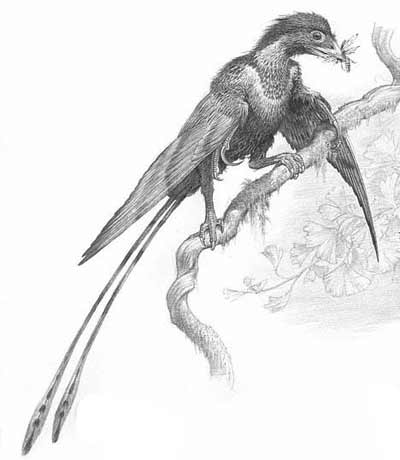 |
| The remarkable, 120 million year old fossil of Schizooura lii |
Now the discovery of a new species of ancient bird is finally allowing us to reconstruct a very important point in their evolutionary history: a split between the groups of primitive birds which would become extinct at the end of the Cretaceous and all others which would either become extinct after the dinosaurs or survive through till today. Earlier this year, a team of palaeontologists, led by graduate student Zhou Shang from the Institute of Vertebrate Palaeontology and Palaeoanthropology were excavating at the early Cretaceous Jiufotang Formation in Jianchang, Liaoning province, China.
 |
| An artist's impression of the early bird Confuciusornis. It is likely that Schizooura lii was very similar to it |
The pygostyle in the more primitive and now extinct Mesozoic birds is little more than a rod of bone. Those in newer species are able to support fans of feathers which are used for display and camouflage. This new, 120 million year old species of bird, named Schizooura lii, has a structure which, until now, was completely unknown in Mesozoic birds and sits somewhere between the two. Schizooura had a tail where the feathers were separated by a deep groove into two sides.
However the muscular structure around the pygostyle would have allowed the creature to fan and retract them. While it was still primitive, it was beginning to use its features for more specialised purposes, a process only seen in more advanced species in animal groups. The ability to fan and retract tail feathers would have given it a means of silent communication with other members of its species. This is useful as an effective alarm to warn of the presence of a predator; or in mating displays.
Complex signalling systems such as these are only found in creatures with a complex and sophisticated social life.This idea is supported by the fact that Schizooura was flightless on account of its highly manoeuvrable tail feathers (birds with the ability to fly have rigid tail feathers which support them in the air and give them added directional control). Therefore it would need an easy way to communicate from the ground or the trees, without making calls which could attract aerial and terrestrial reptilian predators.
Other features suggest that it was adept at running which would make up for its inability to fly. 120 million years ago, China was a vast, crowded and dangerous forest. All of Schizooura's features would have aided it in such a world. In the end, the palaeontologists placed it at the base of a large group of birds known as the Ornithurids, making it the oldest ancestor of all non-primitive birds either living or extinct. If Archaeopteryx is the oldest and most important avian ancestor, then this is certainly the second.